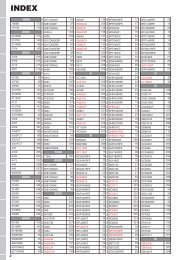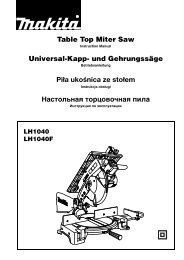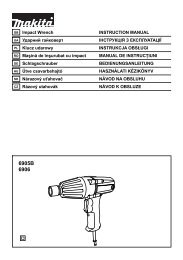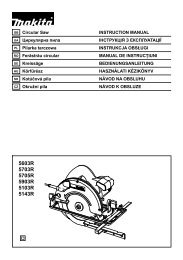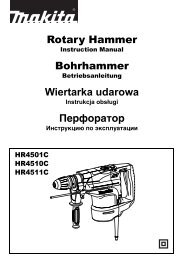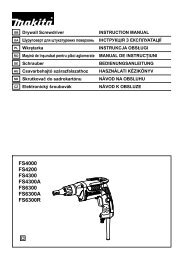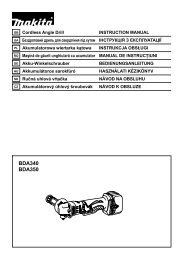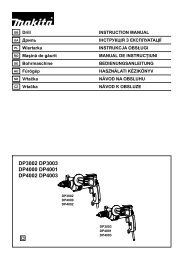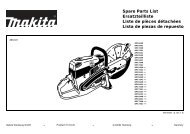GD0601 - Makita
GD0601 - Makita
GD0601 - Makita
Create successful ePaper yourself
Turn your PDF publications into a flip-book with our unique Google optimized e-Paper software.
3. Do not use accessories which are not<br />
specifically designed and recommended by<br />
the tool manufacturer. Just because the<br />
accessory can be attached to your power tool, it<br />
does not assure safe operation.<br />
4. The rated speed of the accessory must be at<br />
least equal to the maximum speed marked on<br />
the power tool. Accessories running faster than<br />
their rated speed can break and fly apart.<br />
5. The outside diameter and the thickness of<br />
your accessory must be within the capacity<br />
rating of your power tool. Incorrectly sized<br />
accessories cannot be adequately guarded or<br />
controlled.<br />
6. Do not use a damaged accessory. Before each<br />
use inspect the accessory such as abrasive<br />
wheels for chips and cracks. If power tool or<br />
accessory is dropped, inspect for damage or<br />
install an undamaged accessory. After<br />
inspecting and installing an accessory,<br />
position yourself and bystanders away from<br />
the plane of the rotating accessory and run the<br />
power tool at maximum no-load speed for one<br />
minute. Damaged accessories will normally<br />
break apart during this test time.<br />
7. Wear personal protective equipment.<br />
Depending on application, use face shield,<br />
safety goggles or safety glasses. As<br />
appropriate, wear dust mask, hearing<br />
protectors, gloves and workshop apron<br />
capable of stopping small abrasive or<br />
workpiece fragments. The eye protection must<br />
be capable of stopping flying debris generated by<br />
various operations . The dust mask or respirator<br />
must be capable of filtrating particles generated<br />
by your operation. Prolonged exposure to high<br />
intensity noise may cause hearing loss.<br />
8. Keep bystanders a safe distance away from<br />
work area. Anyone entering the work area<br />
must wear personal protective equipment.<br />
Fragments of workpiece or of a broken accessory<br />
may fly away and cause injury beyond immediate<br />
area of operation.<br />
9. Hold power tool by insulated gripping<br />
surfaces only, when performing an operation<br />
where the cutting accessory may contact<br />
hidden wiring or its own cord. Cutting<br />
accessory contacting a "live" wire may make<br />
exposed metal parts of the power tool "live" and<br />
shock the operator.<br />
10. Position the cord clear of the spinning<br />
accessory. If you lose control, the cord may be<br />
cut or snagged and your hand or arm may be<br />
pulled into the spinning accessory.<br />
11. Never lay the power tool down until the<br />
accessory has come to a complete stop. The<br />
spinning accessory may grab the surface and pull<br />
the power tool out of your control.<br />
4<br />
12. Do not run the power tool while carrying it at<br />
your side. Accidental contact with the spinning<br />
accessory could snag your clothing, pulling the<br />
accessory into your body.<br />
13. Regularly clean the power tool’s air vents. The<br />
motor’s fan will draw the dust inside the housing<br />
and excessive accumulation of powdered metal<br />
may cause electrical hazards.<br />
14. Do not operate the power tool near flammable<br />
materials. Sparks could ignite these materials.<br />
15. Do not use accessories that require liquid<br />
coolants. Using water or other liquid coolants<br />
may result in electrocution or shock.<br />
16. Kickback and Related Warnings<br />
Kickback is a sudden reaction to a pinched or<br />
snagged rotating wheel, backing pad, brush or<br />
any other accessory. Pinching or snagging causes<br />
rapid stalling of the rotating accessory which in<br />
turn causes the uncontrolled power tool to be<br />
forced in the direction opposite of the accessory’s<br />
rotation at the point of the binding.<br />
For example, if an abrasive wheel is snagged or<br />
pinched by the workpiece, the edge of the wheel<br />
that is entering into the pinch point can dig into the<br />
surface of the material causing the wheel to climb<br />
out or kick out. The wheel may either jump toward<br />
or away from the operator, depending on direction<br />
of the wheel’s movement at the point of pinching.<br />
Abrasive wheels may also break under these<br />
conditions.<br />
Kickback is the result of power tool misuse and/or<br />
incorrect operating procedures or conditions and<br />
can be avoided by taking proper precautions as<br />
given below.<br />
a) Maintain a firm grip on the power tool and<br />
position your body and arm to allow you to<br />
resist kickback forces. Always use auxiliary<br />
handle, if provided, for maximum control over<br />
kickback or torque reaction during start-up. The<br />
operator can control torque reactions or kickback<br />
forces, if proper precautions are taken.<br />
b) Never place your hand near the rotating<br />
accessory. Accessory may kickback over your<br />
hand.<br />
c) Do not position your body in the area where<br />
power tool will move if kickback occurs.<br />
Kickback will propel the tool in direction opposite to<br />
the wheel’s movement at the point of snagging.<br />
d) Use special care when working corners,<br />
sharp edges etc. Avoid bouncing and snagging<br />
the accessory. Corners, sharp edges or bouncing<br />
have a tendency to snag the rotating accessory<br />
and cause loss of control or kickback.<br />
e) Do not attach a saw chain woodcarving blade<br />
or toothed saw blade. Such blades create<br />
frequent kickback and loss of control



